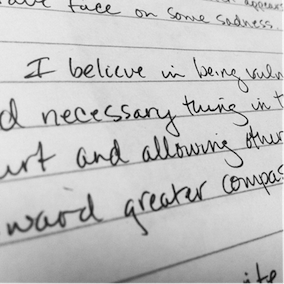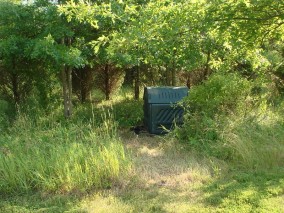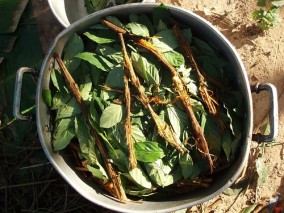I. Compost
If I had a Don’t-Bother list (as opposed to a To-Do list), housekeeping would be at or near the top. My kitchen and bathroom stay reasonably clean, but elsewhere dust and dog hair remain under the radar, taking full advantage of the freedom to assemble. Books, magazines, sheet music, neglected art projects, and shoes can be stacked or shoved aside, and they take no offense.
Trash and recycling are another matter, of course: You can’t ignore household trash, both in its accumulation and increasing odor, and recycling is a civic duty. I take some self-righteous satisfaction in the rituals of disposal: schlepping a garbage bag out to the alley and depositing my bins of bottles and plastic at the front curb, secure in the knowledge that trucks will come and haul my discards to their greater glory (or shameful landfill, as the case may be).
But I can’t work up enthusiasm for the compost pile. For one thing, it stays outside, so it’s easier to ignore. If you’re diligent (which, as I have demonstrated, I am not), you can periodically stir it up and promote its decay by adding compost tea or worms, but otherwise it works its dark, mulchy magic in private. Like an unpopular monarch, an incredibly patient chess player, or a disconsolate drinker, it wants to sit there and mull things over.
In my morning hurry to get to work — walking out with the trash, kitchen compost bucket, book bag, and coffee mug — I fear that one day my keys will slip into the rotting refuse. Rescuing them, particularly in late summer, would mean reaching my hand in among the gooey banana skins and white-furred strawberries. And that would give me pause. I would have to ask: Do I really need the keys now, or could I return later armed with a pair of rubber gloves? More to the point, do we really need the compost? We don’t have a vegetable patch to nurture. Our flower beds are small and unassuming. Sunshine, water, and some encouraging words would probably do the trick.
Intellectually, I understand that composting is simply a version of recycling — a purer one, at that, because it doesn’t require the same tremendous expenditure of energy to transport and process the materials. Emotionally, however, I have yet to observe any benefit. The spring may bring changes that enlighten me. In the meantime, it serves as a memento mori — a reminder of our own flourishing and demise, the eventual breakdown of cells and working parts.
In fact, if we didn’t embalm our bodies at death and encase them in varnished wood, metal, and satin, we too would become a more active part of the process. “Green” burial is not a new idea; it was common custom for thousands of years, but has been interrupted by modern preferences. However, the practice is seeing a renaissance, as it were. The Green Burial Council, a nonprofit established in 2005, educates the public and professionals in the funeral industry, coordinates with environmentalists, and maintains a directory of approved providers who have been certified to meet the Council’s standards. One can envision parks and gardens carpeting the burial grounds. Myself, I like the idea of nourishing a tree or a rosebush.
Coming full cycle, we might see the compost pile as a memento vita: the earth provides food that sustains us, and our organic detritus sustains the earth.
II. Les Très Riches Heures
Photographer John Pfahl knew what to do with a compost pile: He created a series titled The Very Rich Hours of a Compost Pile. The large-format photos, taken throughout 1992-93, create a record, or “a daybook,” as he says, “of both the memorable and mundane meals that grace my table.” He attributes his inspiration for this process to the medieval book of hours. These were handwritten collections of daily devotional readings that included psalms, canonical prayers, and a calendar section of saints’ days and Church feasts. Popular in the late Middle Ages before the invention of the printing press, these illuminated manuscripts could be quite simple and affordable even to commoners, with only a decorated capital letter at the beginning of a prayer. Wealthy patrons, on the other hand, commissioned well-known artists to paint lavish, colorful books using expensive pigments and gold for their miniatures of biblical stories and intricate floral designs.
One of the best-known examples of a book of hours is Les Très Riches Heures du Duc de Berry, or, The Very Rich Hours of the Duke of Berry. Begun in the early fifteenth century by a pair of Dutch brothers named Limbourg, it was finished by another painter, Jean Colombe, between 1485 and 1489. The duke was a powerful and ardent patron of the arts — so much so that he was deeply in debt when he died, in 1416. In addition to numerous chateaux, he had enormous collections of illuminated manuscripts, furniture, fur-trimmed clothing, precious stones, and miniature gold sculptures. The website of the Metropolitan Museum of Art notes that he also had 1,500 hunting dogs.
In a typical book of hours, each month of the calendar section included a list of feast and saints’ days and a modest illustration on the same page. The Limbourg brothers, however, innovated the practice of devoting an entire page to the miniatures. Each month’s scene is topped by a tympanum of cobalt blue representing the arc of the sky, and the stars are consistent with the changing signs of the zodiac. In the center, holding a golden sunburst, travels a man in a chariot.
The calendar section is only a small part of the Très Riches Heures, but the individual scenes under the tympanum allow us an intimate peek into the secular world of fifteenth-century France. For example, January has the duke among friends enjoying a feast and exchanging gifts; April is a marriage, perhaps between the duke’s granddaughter and Charles d’Orléans. May depicts members of the royal court celebrating the first of the month with a traditional horseback ride out in the country, and August is an expedition with falcons. The duke’s chateaux and well-known landmarks, such as the Louvre, are seen in the various backgrounds. The other months showcase the commonplace activities of peasants as they sow and till the fields, harvest wheat or grapes, or huddle indoors before a February fire while outside beehives, dovecotes, and the sheepfold lie beneath a coating of snow.
This calendar section, a record “of both the memorable and the mundane,” is what especially interested John Pfahl. His twentieth-century photographs also capture the signs of seasons passing, but the contrasts between his work and the Limbourgs’ are obvious. Whereas the Très Riches Heures miniatures are about twelve by eight inches, Pfahl’s photos are large-format, about eighteen by twenty-one inches. And while the Limbourg brothers concentrated on people, landscapes, and buildings, Pfahl turns his focus to rotting vegetable matter. Chunks of broken pumpkin surround what’s left of a grinning Jack-o’-lantern, one eye missing, its lone tooth curling in on itself. Two knobby stalks of Brussels sprouts lie on a confetti-bed of smooth, fan-like gingko leaves. Against a snowy backdrop are fennel stalks and whorls of orange peels. Each photo is titled according to its most recent and therefore main element; watermelon rinds, for example, red cabbage, swiss chard in snow. There are also incidental garnishes like black olives, brown maple leaves, and asparagus spears. The title frozen peas only tells part of the story, for the peas are white, more like pearls, and they lie scattered on the snow among unidentifiable scraps of purple, orange, black, and green.
Compositions about decomposition.
III. Northern Lights
During an eight-month sojourn in Norway, I measured time by the amount of garbage I tossed. Another empty milk carton meant that we were that much closer to the day of departure. A crust of cheese meant we’d have fewer Norwegian sandwiches to consume.
I’m ashamed to admit that I was so anxious to leave, when there were many reasons to be thrilled with the adventure. Tromsø is 200 miles north of the Arctic Circle, and how many people can say they’ve been that close to the very top of the world? It’s the home of my ancestors before Hans Hanssen immigrated to the U.S. in the 1880s, a place of mystical fjords, snowy mountains, and thick wool sweaters. It’s a country that consistently ranks very high in quality of life. What’s not to like? What wouldn’t spark interest and imagination?
But our life was lonely. We could take the bus into town, as long as my husband and I were willing to wrestle our resistant four-year-old son, Cosmo, into his snowsuit, boots, and hat, and walk down the street to the bus stop where, it seemed, we arrived just in time to see the bus drive by, or just in time for our boy to decide he needed to pee. When we got to town, we could go to the bookstore or the library — but the comic books he so badly wanted us to read were in Norwegian. Going out to eat was prohibitively expensive; even so, we went to the Kaffe Bønner every Saturday morning to splurge on two cappuccinos, a hot chocolate, and one pastry. These were all exceptionally good. But the real point of our excursion was to get out of the apartment and buy an entrée to city life.
Any interaction with someone who wasn’t behind a counter was harder to come by. On walks through the woods that cover much of the island, or on treks down the hill to the grocery store, I’d pass people who didn’t glance at me, much less say hei. The knowledge that this was cultural, nothing personal, did not help to lessen the pain of isolation. I visited with Åsa, a kind neighbor, who was often out in the street (where cars were not allowed) with a gaggle of toddlers she supervised. Like other Norwegian children, they played outside no matter the weather. (Like other Norwegian mothers, Åsa used to bundle up her own baby and leave the pram out on the balcony, even in freezing temperatures, for his nap.) A year or two younger than Cosmo, the children seemed content just to pull a wagon back and forth or wander within a safe distance. These activities were of no interest whatsoever for my son, however. For distraction, he and I threw snowballs at a brick wall and watched them stick. After a while, we’d go inside and see if there were cartoons on TV, dubbed in Norwegian.
Norwegians don’t generate much trash; except for dairy leftovers, meat scraps, and other messy stuff, they mostly recycle or compost. Residents of our housing complex — hundreds of attached townhouses tiered on a hill, each with a stunning view of the fjord — were provided with two kinds of small plastic bags: one a biodegradable bag for vegetable garbage, which we filled daily, and the other for pure refuse. Whatever else we used was recyclable. At night, I would take a short walk up the hill to deposit the bags in the communal bins. On my way back, I’d pause to look up — and sometimes see the aurora borealis.
Here’s the thing about Northern Norway. The markers that Americans go by to judge the passing of time — dawn, high noon, dusk — are meaningless at certain times of the year. From the summer solstice to the winter solstice, every day is about ten minutes shorter than the one before, so the summer sun practically careens toward its temporary extinction, which officially begins November 22 and ends January 22. Then the earth hunkers down and admits a few meager hours of afternoon twilight in before resigning itself to darkness. And while the weight of this murkiness makes for some dreary, trudging afternoons, it also invites great swaths of green, blue, and red light to move across the sky, vibrating and flowing, shifting in shape from ribbons to curtains to waves that expand and contract on the cosmic stage.
Illumination.
IV. Harley
Harley, a big black dog, lived next door for a couple of years, inside a pen about twelve by eight square feet. His owners had a regular yard, in which their other dog, Snoopy, a manic little Schnauzer who bore no resemblance to his laid-back namesake, was allowed to roam. Most of the time, Snoopy hung out in the house, where he perched like a little tyrant king on the back of the couch, surveying his paltry kingdom through his picture window and barking obsessively at the citizens who dared walk past. Meanwhile, Harley sat in his pen, through rain, snow, and hail, freezing nights and scorching summer days. He had a doghouse but barely fit in it. He sat in his pen, which the owners cleaned infrequently, and waited for something to happen.
Harley had a namesake, too. Our neighbor, Tom, wanted a Harley Davidson, which are very expensive, so the family gave him the dog as a surrogate. It was a funny story until Tom got a motorized Harley, and our furry friend became redundant. He wasn’t exactly treated like trash, but, like potato peels or deliquescing head of lettuce, he was certainly ignored.
One side of his pen bordered part of our property. When a chance for human contact arrived, he’d put his front paws on top of the old wire fence, which swayed with his weight and gratitude. Then his paws gripped the arm that reached over; his tongue flapped at the hand that scratched his handsome head and the white blaze on his chest. It was only a passing visit, though, and he knew it: when you withdrew your arm he gripped it more tightly, desperately wanting to keep you there. Because otherwise it was just a pen full of shit, and his owner may have provided food and water, but he left Harley bereft.
What could we, should we do for that dog? Daily, we walked by Tom’s open garage, where he kept his Harley Davidson, all shiny black. Oddly, the radio was always playing a classic rock station, as though to keep the motorcycle company, but we hardly ever saw Tom. When we did, we were friendly. We didn’t mention that Harley was being terribly mistreated. What would we say? Would you please let him in the house once in a while? Would you clean up his shit? Would you treat him like a living creature and not an old tire? I didn’t have the courage to speak up.
Another neighbor, who fed Harley a warm hot dog every day, got Animal Control to come out and have a look, but as long as he had shelter and food and water, they said they couldn’t do anything.
I thought about knocking on Tom’s front door and asking if I could take Harley for walks once in a while. Like twice a day. I even thought about saying, “Hi, how are you? Say, can I have Harley? I mean, for keeps?” But we already had a dearly loved older dog who deserved our undivided attention; it would seem like a kind of betrayal. Another dog would mean more visits to the vet, more frequent and vigorous exercise, and more worry about finding a place to board when we left town. And Harley wasn’t housetrained.
I didn’t want to confront Tom, even though the worst that could have happened was that he’d say “No.” Then I’d have been embarrassed and Tom might have been offended, or our neighborly relationship might have soured and we’d avoid each other from then on (cringing if we took our trash out to the alley at the same time), even possibly never speaking to each other again — but wasn’t a dog’s welfare worth the risk?
One day Harley was gone. Soon after, his pen was cleaned out. I missed him and worried about him. A couple days went by and I didn’t see Tom or his wife, so I called the shelter, but they didn’t have a recent record of a black dog with a white blaze. I drove to the shelter to look for myself; I drove to the pound. There were plenty of dogs needing a home, but no Harley. Eventually, the hot-dog neighbor passed on the news: Tom had given Harley to a friend, presumably someone who would take better care of him.
I hope Harley gets more attention now and a chance to run and play, but I guess I’ll never know. Here, our golden retriever roams freely in the front yard and enjoys her very rich hours as a dog. If I throw a tennis ball onto the neighbor’s lawn, she might bring it back, or she might just roll on it, four paws in the air, belly exposed, luxuriating in the sensation. She also likes to lie on the grass or the porch, alert to smells on the wind, and watch people go by. If she gets a friendly greeting, she trots over for a pet, and in the receiving, gives her visitors joy. This is the kind of memorable and mundane grace that dogs provide us every day: an opportunity for connection and renewal.
Michele Hanson’s work has appeared in Copper Nickel and Travelers Tales: A Mother’s World. She teaches at Colorado Mesa University in Grand Junction, where she lives with her son and dog.





